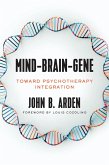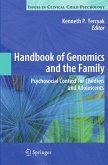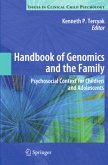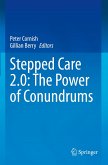Michele Di Salvo
A Perspective on the Neurobiological Basis of Autism
Michele Di Salvo
A Perspective on the Neurobiological Basis of Autism
- Gebundenes Buch
- Merkliste
- Auf die Merkliste
- Bewerten Bewerten
- Teilen
- Produkt teilen
- Produkterinnerung
- Produkterinnerung
This unique book explores the validity of early neuroinflammation as the cause of autism. If in his previous book, the author had focused on the evolution of the diagnosis of autism over the last century, delving into the psychological, epidemiological and sociological aspects, in this book - the most comprehensive and articulate on this aspect - he has concentrated on the synthesis of research by deepening the discussion of topics related to genetic research, heavy metals, the process of infection and neuroinflammation, and the BDNF thesis. It covers the most accepted scientific theories,…mehr
Andere Kunden interessierten sich auch für
![Mind-Brain-Gene: Toward Psychotherapy Integration Mind-Brain-Gene: Toward Psychotherapy Integration]() John ArdenMind-Brain-Gene: Toward Psychotherapy Integration35,99 €
John ArdenMind-Brain-Gene: Toward Psychotherapy Integration35,99 €![Handbook of Genomics and the Family Handbook of Genomics and the Family]() Handbook of Genomics and the Family200,99 €
Handbook of Genomics and the Family200,99 €![Handbook of Genomics and the Family Handbook of Genomics and the Family]() Kenneth P. Tercyak (Hrsg.)Handbook of Genomics and the Family288,99 €
Kenneth P. Tercyak (Hrsg.)Handbook of Genomics and the Family288,99 €![Stepped Care 2.0: The Power of Conundrums Stepped Care 2.0: The Power of Conundrums]() Stepped Care 2.0: The Power of Conundrums53,99 €
Stepped Care 2.0: The Power of Conundrums53,99 €![The Research Basis for Autism Intervention The Research Basis for Autism Intervention]() Eric Schopler / Nurit Yirmiya / Cory Shulman / Lee M. Marcus (Hgg.)The Research Basis for Autism Intervention77,99 €
Eric Schopler / Nurit Yirmiya / Cory Shulman / Lee M. Marcus (Hgg.)The Research Basis for Autism Intervention77,99 €![Understanding the Biological Basis of Behavior Understanding the Biological Basis of Behavior]() Understanding the Biological Basis of Behavior68,99 €
Understanding the Biological Basis of Behavior68,99 €![Psychoses of the Schizophrenic Spectrum in Twins Psychoses of the Schizophrenic Spectrum in Twins]() Ernst FranzekPsychoses of the Schizophrenic Spectrum in Twins39,99 €
Ernst FranzekPsychoses of the Schizophrenic Spectrum in Twins39,99 €-
-
-
This unique book explores the validity of early neuroinflammation as the cause of autism. If in his previous book, the author had focused on the evolution of the diagnosis of autism over the last century, delving into the psychological, epidemiological and sociological aspects, in this book - the most comprehensive and articulate on this aspect - he has concentrated on the synthesis of research by deepening the discussion of topics related to genetic research, heavy metals, the process of infection and neuroinflammation, and the BDNF thesis. It covers the most accepted scientific theories, providing an overview of new frontiers of research. Finally, it introduces new strategies and tools for diagnosis and new frontiers of intervention. It will be a useful resource for professionals and researchers in autism spectrum disorders and neurobiology. It will also be an interesting read for undergraduate and postgraduate students of autism, neuroscience and genetics.
Produktdetails
- Produktdetails
- Verlag: Taylor & Francis Ltd
- Seitenzahl: 312
- Erscheinungstermin: 21. November 2025
- Englisch
- Abmessung: 234mm x 156mm
- ISBN-13: 9781041126614
- ISBN-10: 1041126611
- Artikelnr.: 75197845
- Herstellerkennzeichnung
- Libri GmbH
- Europaallee 1
- 36244 Bad Hersfeld
- gpsr@libri.de
- Verlag: Taylor & Francis Ltd
- Seitenzahl: 312
- Erscheinungstermin: 21. November 2025
- Englisch
- Abmessung: 234mm x 156mm
- ISBN-13: 9781041126614
- ISBN-10: 1041126611
- Artikelnr.: 75197845
- Herstellerkennzeichnung
- Libri GmbH
- Europaallee 1
- 36244 Bad Hersfeld
- gpsr@libri.de
Michele Di Salvo is Director NeuralNexus of ENIA (National Entity for AI) and Chief of Board of CrossMedia Labs. He is a member of numerous associations and scientific research groups, including Society for Neuroscience, European Federation of Neuroscience Societies, International Neuropsychoanalysis Society and Cognitive Neuroscience Society. His research focuses on the neuroscientific foundations of psychology.
Chapter 1 FROM "AUTISM RESEARCH BETWEEN PSYCHOLOGY AND NEUROSCIENCE" TO "A PERSPECTIVE ON THE NEUROBIOLOGICAL BASIS OF AUTISM AND NEW FRONTIERS". Chapter 2 THE ROLE OF BDNF IN THE ONSET OF AUTISM
The Thesis I Proposed
The Role of BDNF
The BDNF Dysfunction/Disregulation Thesis
The Basis of Genetic Susceptibility
Experimental Evidence (Updated)
A Unified Proposal
The Central Role of BDNF
A Different Definition of Autism Chapter 3 THE ORIGIN OF CONNECTOPATHY: A CIRCUIT HYPOTHESIS OF NEUROINFLAMMATION AND BDNF DYSREGULATION IN THE ONSET OF AUTISM
Autism as a Connectopathy
The Neuroinflammatory Hypothesis
Patterns of the Neuroinflammatory Process Chapter 4 GENETICS, EPIGENETICS AND ENVIRONMENT IN AUTISM
From Genetic Susceptibility To Epigenetics
The Immune System Of The Brain And Its Relationship With The Digestive System
Gastrointestinal Problems In Autistic People Chapter 5 GENETIC RESEARCH INTO AUTISM: THE "GENETIC SUSCEPTIBILITY BASIS"
Molecular Genetics and the Emergence of the "Autism Spectrum"
"De Novo" Mutations
The Overall State of Autism Genetics Research
Major Genes Involved in Autism Chapter 6 THE CENTRAL ROLE OF SHANK FAMILY GENES IN INFLAMMATION AND AUTISM
The SHANK Protein Family
The Shank-Inflammation Link
Shank-Zinc Correlation
Synaptic assembly of ProSAP1/Shank2 and ProSAP2/Shank3 proteins is affected by Zn2+ deficiency Chapter 7 CEREBRAL CHARACTERISTICS IN AUTISM AND THE ROLE OF SHANK FAMILY GENES
The Role of Shank Family Genes in Synaptic Configuration
The Association Of The AMPA Receptor With Dysfunction The Cerebro-Cerebellar Circuit in Autism
AMPA Receptors And Dendritic Compartment Physiology
Phelan Mcdermid syndrome, 22q13 deletion And Other Autistic Etiologies Related To SHANK3
Cerebellar Involvement in Autism
Cerebellar Anatomy And Neuronal Specification Chapter 8 SHANK GENES, ZINC AND GLUTAMATE RECEPTORS IN THE AETIOLOGY OF AUTISM
NMDAR and Synaptic Plasticity
Zinc and NMDAR
Pathological Effects on NMDAR Receptors
Role of SHANKs with NMDAR in Autism Spectrum Disorders Chapter 9 DOPAMINE RECEPTORS IN THE ETIOLOGY OF AUTISM
Dopamine BDNF and Autism Ontogenesis
Mesolimbic DAergic Social Reward, Brain Excitatory-Inhibitory Balance and Autism
Dysregulated Neurotransmitter Signaling in Autism
DAergic Dysregulation and Neurocognitive Manifestations in Autism Chapter 10 THE ROLE OF ZINC AND THE IMMUNE SYSTEM IN THE AETIOLOGY OF AUTISM
The Role Of Zinc
Zinc's Role in the Immune System
Zinc-Serotonin Interaction
Zinc and the Immune System
The Relationship Between Zinc's Role in Metabolism And the Comorbidities of Autism
Sensory Perception, Food Selectivity And Zn In Autistic People
Biomarkers of Autism
Zinc And Microbiota In Autism Chapter 11 INFLAMMATORY PROCESSES IN THE PATHOGENESIS OF AUTISM
Microglia-Mediated Neuroinflammation
Neuroinflammation in Autism
The Role of H3R in Microglial Activation And Neuroinflammation in Autism Chapter 12 THE ROLE OF ZINC IN INFLAMMATION PROCESS IN THE AETIOLOGY OF AUTISM
The Role of Zinc
NF-
B and Other Signaling Pathways
Oxidative Stress
Zinc Status and Inflammatory Cytokines
Zinc in Infection and Nutritional Immunity
Zinc as a Critical Component of the Membrane Barrier Chapter 13 PRENATAL INFECTION AND INFLAMMATION IN THE AETIOLOGY OF AUTISM
MicroRNA Dysregulation in the Pathophysiology of Autism Chapter 14 THE ROLE OF METALS AND TRACE ELEMENTS IN THE AETIOLOGY OF AUTISM
Trace Elements Characteristics And Their Roles in Biological Functions
The Role of Trace Metals in Autism
Individual Elements
Trace Metal Homeostasis and Autism
Mechanisms Involved in Environmental Influence On Neurodevelopment Chapter 15 PATHOMECHANISM OF METALS IN AUTISM
Association Between Autism And Metals
Pathomechanisms of Heavy Metal Overload in Autism
Oxidative Stress and Mitochondrial Dysfunction
Neuroinflammation
Axonal Demyelination
Competition with Essential Metals and Specifically Zinc
Toxic Metals That Cause Zinc Deficiency
Deficiencies Chapter 16 THE ROLE OF SUSCEPTIBILITY-INDUCING COFACTORS IN THE AETIOLOGY OF AUTISM: ACETAMINOPHEN, PARACETAMOL AND GLYSOPHATE
Acetaminophen Metabolism
Acetaminophen and Glyphosate Emergencies
The Role of Vasostatin1 in the Neuroinflammatory Process Chapter 17 NEW DIAGNOSTIC TOOLS (NOT ONLY) FOR AUTISM
How Artificial Intelligence and Machine Learning Can Contribute to Research and Diagnosis
The TBM
The Quantum Magnetic Resonance Analyzer (QMRA)
Gaming Chapter 18 NEW THERAPEUTIC INTERVENTION TOOLS (NOT ONLY) FOR AUTISM
The Zn-Shankopathies Relationship
Shank3 Lithium Treatment
Zinc Deficiencies and Supplements
Other Pathways of Action on Neurotransmitters and Histamine
Choline Supplementation Chapter 19 CONCLUSIONS INDEX
Names Index
Word-Subjects Index
The Thesis I Proposed
The Role of BDNF
The BDNF Dysfunction/Disregulation Thesis
The Basis of Genetic Susceptibility
Experimental Evidence (Updated)
A Unified Proposal
The Central Role of BDNF
A Different Definition of Autism Chapter 3 THE ORIGIN OF CONNECTOPATHY: A CIRCUIT HYPOTHESIS OF NEUROINFLAMMATION AND BDNF DYSREGULATION IN THE ONSET OF AUTISM
Autism as a Connectopathy
The Neuroinflammatory Hypothesis
Patterns of the Neuroinflammatory Process Chapter 4 GENETICS, EPIGENETICS AND ENVIRONMENT IN AUTISM
From Genetic Susceptibility To Epigenetics
The Immune System Of The Brain And Its Relationship With The Digestive System
Gastrointestinal Problems In Autistic People Chapter 5 GENETIC RESEARCH INTO AUTISM: THE "GENETIC SUSCEPTIBILITY BASIS"
Molecular Genetics and the Emergence of the "Autism Spectrum"
"De Novo" Mutations
The Overall State of Autism Genetics Research
Major Genes Involved in Autism Chapter 6 THE CENTRAL ROLE OF SHANK FAMILY GENES IN INFLAMMATION AND AUTISM
The SHANK Protein Family
The Shank-Inflammation Link
Shank-Zinc Correlation
Synaptic assembly of ProSAP1/Shank2 and ProSAP2/Shank3 proteins is affected by Zn2+ deficiency Chapter 7 CEREBRAL CHARACTERISTICS IN AUTISM AND THE ROLE OF SHANK FAMILY GENES
The Role of Shank Family Genes in Synaptic Configuration
The Association Of The AMPA Receptor With Dysfunction The Cerebro-Cerebellar Circuit in Autism
AMPA Receptors And Dendritic Compartment Physiology
Phelan Mcdermid syndrome, 22q13 deletion And Other Autistic Etiologies Related To SHANK3
Cerebellar Involvement in Autism
Cerebellar Anatomy And Neuronal Specification Chapter 8 SHANK GENES, ZINC AND GLUTAMATE RECEPTORS IN THE AETIOLOGY OF AUTISM
NMDAR and Synaptic Plasticity
Zinc and NMDAR
Pathological Effects on NMDAR Receptors
Role of SHANKs with NMDAR in Autism Spectrum Disorders Chapter 9 DOPAMINE RECEPTORS IN THE ETIOLOGY OF AUTISM
Dopamine BDNF and Autism Ontogenesis
Mesolimbic DAergic Social Reward, Brain Excitatory-Inhibitory Balance and Autism
Dysregulated Neurotransmitter Signaling in Autism
DAergic Dysregulation and Neurocognitive Manifestations in Autism Chapter 10 THE ROLE OF ZINC AND THE IMMUNE SYSTEM IN THE AETIOLOGY OF AUTISM
The Role Of Zinc
Zinc's Role in the Immune System
Zinc-Serotonin Interaction
Zinc and the Immune System
The Relationship Between Zinc's Role in Metabolism And the Comorbidities of Autism
Sensory Perception, Food Selectivity And Zn In Autistic People
Biomarkers of Autism
Zinc And Microbiota In Autism Chapter 11 INFLAMMATORY PROCESSES IN THE PATHOGENESIS OF AUTISM
Microglia-Mediated Neuroinflammation
Neuroinflammation in Autism
The Role of H3R in Microglial Activation And Neuroinflammation in Autism Chapter 12 THE ROLE OF ZINC IN INFLAMMATION PROCESS IN THE AETIOLOGY OF AUTISM
The Role of Zinc
NF-
B and Other Signaling Pathways
Oxidative Stress
Zinc Status and Inflammatory Cytokines
Zinc in Infection and Nutritional Immunity
Zinc as a Critical Component of the Membrane Barrier Chapter 13 PRENATAL INFECTION AND INFLAMMATION IN THE AETIOLOGY OF AUTISM
MicroRNA Dysregulation in the Pathophysiology of Autism Chapter 14 THE ROLE OF METALS AND TRACE ELEMENTS IN THE AETIOLOGY OF AUTISM
Trace Elements Characteristics And Their Roles in Biological Functions
The Role of Trace Metals in Autism
Individual Elements
Trace Metal Homeostasis and Autism
Mechanisms Involved in Environmental Influence On Neurodevelopment Chapter 15 PATHOMECHANISM OF METALS IN AUTISM
Association Between Autism And Metals
Pathomechanisms of Heavy Metal Overload in Autism
Oxidative Stress and Mitochondrial Dysfunction
Neuroinflammation
Axonal Demyelination
Competition with Essential Metals and Specifically Zinc
Toxic Metals That Cause Zinc Deficiency
Deficiencies Chapter 16 THE ROLE OF SUSCEPTIBILITY-INDUCING COFACTORS IN THE AETIOLOGY OF AUTISM: ACETAMINOPHEN, PARACETAMOL AND GLYSOPHATE
Acetaminophen Metabolism
Acetaminophen and Glyphosate Emergencies
The Role of Vasostatin1 in the Neuroinflammatory Process Chapter 17 NEW DIAGNOSTIC TOOLS (NOT ONLY) FOR AUTISM
How Artificial Intelligence and Machine Learning Can Contribute to Research and Diagnosis
The TBM
The Quantum Magnetic Resonance Analyzer (QMRA)
Gaming Chapter 18 NEW THERAPEUTIC INTERVENTION TOOLS (NOT ONLY) FOR AUTISM
The Zn-Shankopathies Relationship
Shank3 Lithium Treatment
Zinc Deficiencies and Supplements
Other Pathways of Action on Neurotransmitters and Histamine
Choline Supplementation Chapter 19 CONCLUSIONS INDEX
Names Index
Word-Subjects Index
Chapter 1 FROM "AUTISM RESEARCH BETWEEN PSYCHOLOGY AND NEUROSCIENCE" TO "A PERSPECTIVE ON THE NEUROBIOLOGICAL BASIS OF AUTISM AND NEW FRONTIERS". Chapter 2 THE ROLE OF BDNF IN THE ONSET OF AUTISM
The Thesis I Proposed
The Role of BDNF
The BDNF Dysfunction/Disregulation Thesis
The Basis of Genetic Susceptibility
Experimental Evidence (Updated)
A Unified Proposal
The Central Role of BDNF
A Different Definition of Autism Chapter 3 THE ORIGIN OF CONNECTOPATHY: A CIRCUIT HYPOTHESIS OF NEUROINFLAMMATION AND BDNF DYSREGULATION IN THE ONSET OF AUTISM
Autism as a Connectopathy
The Neuroinflammatory Hypothesis
Patterns of the Neuroinflammatory Process Chapter 4 GENETICS, EPIGENETICS AND ENVIRONMENT IN AUTISM
From Genetic Susceptibility To Epigenetics
The Immune System Of The Brain And Its Relationship With The Digestive System
Gastrointestinal Problems In Autistic People Chapter 5 GENETIC RESEARCH INTO AUTISM: THE "GENETIC SUSCEPTIBILITY BASIS"
Molecular Genetics and the Emergence of the "Autism Spectrum"
"De Novo" Mutations
The Overall State of Autism Genetics Research
Major Genes Involved in Autism Chapter 6 THE CENTRAL ROLE OF SHANK FAMILY GENES IN INFLAMMATION AND AUTISM
The SHANK Protein Family
The Shank-Inflammation Link
Shank-Zinc Correlation
Synaptic assembly of ProSAP1/Shank2 and ProSAP2/Shank3 proteins is affected by Zn2+ deficiency Chapter 7 CEREBRAL CHARACTERISTICS IN AUTISM AND THE ROLE OF SHANK FAMILY GENES
The Role of Shank Family Genes in Synaptic Configuration
The Association Of The AMPA Receptor With Dysfunction The Cerebro-Cerebellar Circuit in Autism
AMPA Receptors And Dendritic Compartment Physiology
Phelan Mcdermid syndrome, 22q13 deletion And Other Autistic Etiologies Related To SHANK3
Cerebellar Involvement in Autism
Cerebellar Anatomy And Neuronal Specification Chapter 8 SHANK GENES, ZINC AND GLUTAMATE RECEPTORS IN THE AETIOLOGY OF AUTISM
NMDAR and Synaptic Plasticity
Zinc and NMDAR
Pathological Effects on NMDAR Receptors
Role of SHANKs with NMDAR in Autism Spectrum Disorders Chapter 9 DOPAMINE RECEPTORS IN THE ETIOLOGY OF AUTISM
Dopamine BDNF and Autism Ontogenesis
Mesolimbic DAergic Social Reward, Brain Excitatory-Inhibitory Balance and Autism
Dysregulated Neurotransmitter Signaling in Autism
DAergic Dysregulation and Neurocognitive Manifestations in Autism Chapter 10 THE ROLE OF ZINC AND THE IMMUNE SYSTEM IN THE AETIOLOGY OF AUTISM
The Role Of Zinc
Zinc's Role in the Immune System
Zinc-Serotonin Interaction
Zinc and the Immune System
The Relationship Between Zinc's Role in Metabolism And the Comorbidities of Autism
Sensory Perception, Food Selectivity And Zn In Autistic People
Biomarkers of Autism
Zinc And Microbiota In Autism Chapter 11 INFLAMMATORY PROCESSES IN THE PATHOGENESIS OF AUTISM
Microglia-Mediated Neuroinflammation
Neuroinflammation in Autism
The Role of H3R in Microglial Activation And Neuroinflammation in Autism Chapter 12 THE ROLE OF ZINC IN INFLAMMATION PROCESS IN THE AETIOLOGY OF AUTISM
The Role of Zinc
NF-
B and Other Signaling Pathways
Oxidative Stress
Zinc Status and Inflammatory Cytokines
Zinc in Infection and Nutritional Immunity
Zinc as a Critical Component of the Membrane Barrier Chapter 13 PRENATAL INFECTION AND INFLAMMATION IN THE AETIOLOGY OF AUTISM
MicroRNA Dysregulation in the Pathophysiology of Autism Chapter 14 THE ROLE OF METALS AND TRACE ELEMENTS IN THE AETIOLOGY OF AUTISM
Trace Elements Characteristics And Their Roles in Biological Functions
The Role of Trace Metals in Autism
Individual Elements
Trace Metal Homeostasis and Autism
Mechanisms Involved in Environmental Influence On Neurodevelopment Chapter 15 PATHOMECHANISM OF METALS IN AUTISM
Association Between Autism And Metals
Pathomechanisms of Heavy Metal Overload in Autism
Oxidative Stress and Mitochondrial Dysfunction
Neuroinflammation
Axonal Demyelination
Competition with Essential Metals and Specifically Zinc
Toxic Metals That Cause Zinc Deficiency
Deficiencies Chapter 16 THE ROLE OF SUSCEPTIBILITY-INDUCING COFACTORS IN THE AETIOLOGY OF AUTISM: ACETAMINOPHEN, PARACETAMOL AND GLYSOPHATE
Acetaminophen Metabolism
Acetaminophen and Glyphosate Emergencies
The Role of Vasostatin1 in the Neuroinflammatory Process Chapter 17 NEW DIAGNOSTIC TOOLS (NOT ONLY) FOR AUTISM
How Artificial Intelligence and Machine Learning Can Contribute to Research and Diagnosis
The TBM
The Quantum Magnetic Resonance Analyzer (QMRA)
Gaming Chapter 18 NEW THERAPEUTIC INTERVENTION TOOLS (NOT ONLY) FOR AUTISM
The Zn-Shankopathies Relationship
Shank3 Lithium Treatment
Zinc Deficiencies and Supplements
Other Pathways of Action on Neurotransmitters and Histamine
Choline Supplementation Chapter 19 CONCLUSIONS INDEX
Names Index
Word-Subjects Index
The Thesis I Proposed
The Role of BDNF
The BDNF Dysfunction/Disregulation Thesis
The Basis of Genetic Susceptibility
Experimental Evidence (Updated)
A Unified Proposal
The Central Role of BDNF
A Different Definition of Autism Chapter 3 THE ORIGIN OF CONNECTOPATHY: A CIRCUIT HYPOTHESIS OF NEUROINFLAMMATION AND BDNF DYSREGULATION IN THE ONSET OF AUTISM
Autism as a Connectopathy
The Neuroinflammatory Hypothesis
Patterns of the Neuroinflammatory Process Chapter 4 GENETICS, EPIGENETICS AND ENVIRONMENT IN AUTISM
From Genetic Susceptibility To Epigenetics
The Immune System Of The Brain And Its Relationship With The Digestive System
Gastrointestinal Problems In Autistic People Chapter 5 GENETIC RESEARCH INTO AUTISM: THE "GENETIC SUSCEPTIBILITY BASIS"
Molecular Genetics and the Emergence of the "Autism Spectrum"
"De Novo" Mutations
The Overall State of Autism Genetics Research
Major Genes Involved in Autism Chapter 6 THE CENTRAL ROLE OF SHANK FAMILY GENES IN INFLAMMATION AND AUTISM
The SHANK Protein Family
The Shank-Inflammation Link
Shank-Zinc Correlation
Synaptic assembly of ProSAP1/Shank2 and ProSAP2/Shank3 proteins is affected by Zn2+ deficiency Chapter 7 CEREBRAL CHARACTERISTICS IN AUTISM AND THE ROLE OF SHANK FAMILY GENES
The Role of Shank Family Genes in Synaptic Configuration
The Association Of The AMPA Receptor With Dysfunction The Cerebro-Cerebellar Circuit in Autism
AMPA Receptors And Dendritic Compartment Physiology
Phelan Mcdermid syndrome, 22q13 deletion And Other Autistic Etiologies Related To SHANK3
Cerebellar Involvement in Autism
Cerebellar Anatomy And Neuronal Specification Chapter 8 SHANK GENES, ZINC AND GLUTAMATE RECEPTORS IN THE AETIOLOGY OF AUTISM
NMDAR and Synaptic Plasticity
Zinc and NMDAR
Pathological Effects on NMDAR Receptors
Role of SHANKs with NMDAR in Autism Spectrum Disorders Chapter 9 DOPAMINE RECEPTORS IN THE ETIOLOGY OF AUTISM
Dopamine BDNF and Autism Ontogenesis
Mesolimbic DAergic Social Reward, Brain Excitatory-Inhibitory Balance and Autism
Dysregulated Neurotransmitter Signaling in Autism
DAergic Dysregulation and Neurocognitive Manifestations in Autism Chapter 10 THE ROLE OF ZINC AND THE IMMUNE SYSTEM IN THE AETIOLOGY OF AUTISM
The Role Of Zinc
Zinc's Role in the Immune System
Zinc-Serotonin Interaction
Zinc and the Immune System
The Relationship Between Zinc's Role in Metabolism And the Comorbidities of Autism
Sensory Perception, Food Selectivity And Zn In Autistic People
Biomarkers of Autism
Zinc And Microbiota In Autism Chapter 11 INFLAMMATORY PROCESSES IN THE PATHOGENESIS OF AUTISM
Microglia-Mediated Neuroinflammation
Neuroinflammation in Autism
The Role of H3R in Microglial Activation And Neuroinflammation in Autism Chapter 12 THE ROLE OF ZINC IN INFLAMMATION PROCESS IN THE AETIOLOGY OF AUTISM
The Role of Zinc
NF-
B and Other Signaling Pathways
Oxidative Stress
Zinc Status and Inflammatory Cytokines
Zinc in Infection and Nutritional Immunity
Zinc as a Critical Component of the Membrane Barrier Chapter 13 PRENATAL INFECTION AND INFLAMMATION IN THE AETIOLOGY OF AUTISM
MicroRNA Dysregulation in the Pathophysiology of Autism Chapter 14 THE ROLE OF METALS AND TRACE ELEMENTS IN THE AETIOLOGY OF AUTISM
Trace Elements Characteristics And Their Roles in Biological Functions
The Role of Trace Metals in Autism
Individual Elements
Trace Metal Homeostasis and Autism
Mechanisms Involved in Environmental Influence On Neurodevelopment Chapter 15 PATHOMECHANISM OF METALS IN AUTISM
Association Between Autism And Metals
Pathomechanisms of Heavy Metal Overload in Autism
Oxidative Stress and Mitochondrial Dysfunction
Neuroinflammation
Axonal Demyelination
Competition with Essential Metals and Specifically Zinc
Toxic Metals That Cause Zinc Deficiency
Deficiencies Chapter 16 THE ROLE OF SUSCEPTIBILITY-INDUCING COFACTORS IN THE AETIOLOGY OF AUTISM: ACETAMINOPHEN, PARACETAMOL AND GLYSOPHATE
Acetaminophen Metabolism
Acetaminophen and Glyphosate Emergencies
The Role of Vasostatin1 in the Neuroinflammatory Process Chapter 17 NEW DIAGNOSTIC TOOLS (NOT ONLY) FOR AUTISM
How Artificial Intelligence and Machine Learning Can Contribute to Research and Diagnosis
The TBM
The Quantum Magnetic Resonance Analyzer (QMRA)
Gaming Chapter 18 NEW THERAPEUTIC INTERVENTION TOOLS (NOT ONLY) FOR AUTISM
The Zn-Shankopathies Relationship
Shank3 Lithium Treatment
Zinc Deficiencies and Supplements
Other Pathways of Action on Neurotransmitters and Histamine
Choline Supplementation Chapter 19 CONCLUSIONS INDEX
Names Index
Word-Subjects Index








